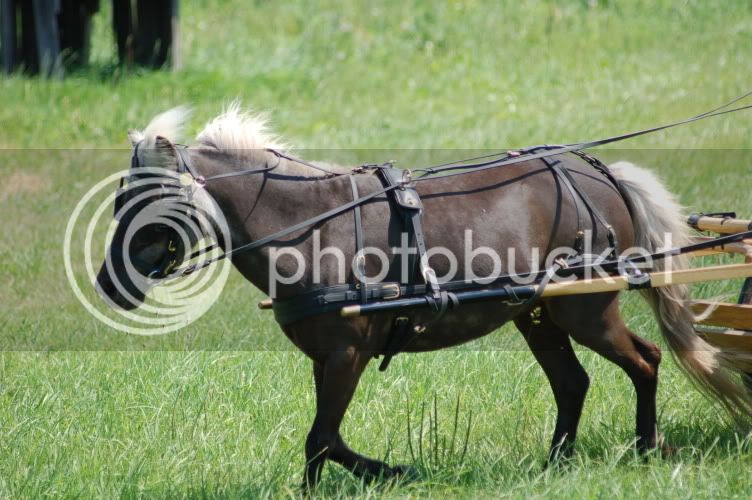If you are willing to spend a little more, it will be hard to beat a Smuckers harness. They are now making a very nice betathane harness-I believe the Pleasure harness in beta is just under $500. Smuckers has a longtime excellent reputation(and yes, they are Amish!) They do have a website-just google "Smuckers harness shop". Their beta harness, I believe, would even 'do' for the show ring. If you get a check, get a sidecheck. (Rabbitsfizz didn't mention that in AMHA and AMHR breed approved shows in the US, one kind or the other IS REQUIRED by the rules.) Personally, I do not ever use an overcheck; if I use a check outside the show ring, it is a sidecheck, kindly adjusted, and utilized to help prevent 'grass grabbing' by my drylotted horses(not all of us live where there is always pasture, you know....!) - I often drive without even that. If I knew that a horse would never be going to the miniature breed show ring, I would not use any check-but, it certainly does NOT hurt a horse to learn to accept a sidecheck which does NOT come into play unless/until the horse tries to drop its head to the ground.
I have a student who has an easy entry 'pipe' cart that looks to be the brand you posted the link to-came with brakes(IMO, after 22 years of driving, brakes are NOT necessary, nor even desirable, in a (two wheeled), miniature horse pleasure cart.) We found we could not use his cart(he got it with a supposedly trained driving mare-yeah, as long as you don't ask her to stop and stand still, or drive away from her own premises,or turn....another whole story, however.) The cart came with one of those 'trailers'-which I would not HAVE. The cart's basket(where you place your feet) is very shallow-even I, who am only 5'5", have my knees doubled uncomfortably in it(and in the website photo, the MN one looks the same)-when training his young(a different one!)mare(once we were really to hitch her, I had him bring his own vehicle, so she would be used to it), I shortly found her developing a resistance to turning, and observed that it was due to the shaft placement on that (awful!)cart-it could NOT be adjusted(traces lengthened or shortened, or tug loops raised or lowered-I tried all that)to be any better; it was literally 'stabbing' the mare when she was asked for more than the gentlest of turns. I told him we would not be using it anymore-and since this is the cart that came with the other mare, I now suspect it might be one cause of some of her driving issues!
I have and use, and have, since 1985, a Frontier easy entry pipe cart. I have NO connection with them, but for the price and the desired usage, I don't believe you can find any better brand/make. If you want something a bit higher level in an easy entry pipe cart,I would suggest you check out Lignite carts,or, Eazy Ryder carts-again, all of these companies may be googled(Frontier Trading Co.)
There are many 'knock offs' out there-it pays to be careful, or to take a KNOWLEDGEABLE driver with you when you shop. Easy entry carts are popular for training/everyday/trail driving because they are easy to get in and out of, quickly-and if properly made, are reasonably sturdy and light(the Frontier is around 85 lbs, w/o brakes, so I have to wonder about the stated weight of the cart you posted-the one my student got was noticably heavier than the Frontier; even after he removed the HEAVY DUTY(?) brake plates.) Leia is correct that for this type of cart, that weight is about right. Depending on how you wish to use the vehicle(and considering proper strength of construction, of course), it is hard for a miniature horse vehicle to be 'too light'. Drawbacks can be the pneumatic tires(flats!), but there are ways to deal with that-no-flat inserts, buying metal/wooden wheels to fit one, etc. The shaft configuration is high draft, and doesn't allow much by way of real maneuverabilty for the horse-but these aren't really issues unless/until you get into fairly advanced, CDE-type, driving.
I have seen TOO MANY people end up with 'junk' because they didn't do their homework-good for you for doing yours. Like most other things, you will generally get what you pay for-for not all that much more, you can often get a much better product-IF you know where to shop. Finally, I don't recommend buying any harness off of ebay.
Best wishes driving!
Margo




